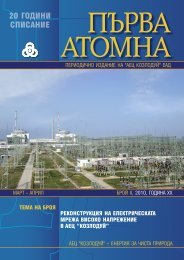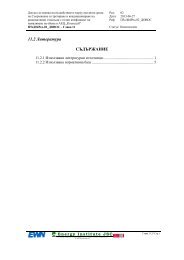Summary Report for Conduct of Kozloduy NPP Stress Tests
Summary Report for Conduct of Kozloduy NPP Stress Tests
Summary Report for Conduct of Kozloduy NPP Stress Tests
You also want an ePaper? Increase the reach of your titles
YUMPU automatically turns print PDFs into web optimized ePapers that Google loves.
“<strong>Kozloduy</strong> <strong>NPP</strong>” PLC<br />
SUMMARY REPORT<br />
<strong>for</strong> <strong>Conduct</strong> <strong>of</strong> <strong>Kozloduy</strong> <strong>NPP</strong><br />
<strong>Stress</strong> <strong>Tests</strong><br />
leading to determining the bearing capacity <strong>of</strong> the elements and determination <strong>of</strong> sections, in which<br />
boundary de<strong>for</strong>mation and loss <strong>of</strong> bearing capacity occurs. The ro<strong>of</strong>s <strong>of</strong> the above structures have<br />
sufficient bearing capacity to accommodate the load <strong>of</strong> snow according to the new standards.<br />
4.3.1.2.3 Rein<strong>for</strong>ced concrete ventilation pipe<br />
Due to its constructive features it is not affected by snowfalls and freezing.<br />
4.3.1.2.4 Spray pools<br />
The snowfalls do not apply pressure on their structure.<br />
4.3.1.3 Extreme temperatures<br />
High temperatures, to the maximum measured <strong>for</strong> the area <strong>of</strong> <strong>Kozloduy</strong> <strong>NPP</strong> do not bear<br />
mechanical loads on structures and buildings at Units 3 and 4.<br />
In the given design basis extreme values <strong>of</strong> temperatures do not lead to failure to the plant<br />
safety functions.<br />
In the operational history <strong>of</strong> the plant there are no events and accident initiated by extremely<br />
low or extremely high temperatures.<br />
4.3.1.3.1 SFP 3, 4<br />
Due to the closing and autonomous nature <strong>of</strong> the spent fuel storage system and auxiliary<br />
systems, these are not affected by the external factors „Extreme temperatures”.<br />
4.3.1.3.2 Spray pools<br />
Design flow <strong>of</strong> sources <strong>of</strong> supplemental water is sufficient to compensate <strong>for</strong> evaporation<br />
losses at extremely high temperatures.<br />
The technological temperature mode <strong>of</strong> the spray pools provides <strong>for</strong> non-freezing <strong>of</strong> the<br />
water even at extreme temperatures.<br />
4.3.1.4 Freezing<br />
For technological provision <strong>of</strong> the required temperature mode and protection <strong>of</strong> CPS 1-4<br />
pumps against freezing recirculation <strong>of</strong> hot water is set be<strong>for</strong>e CPS 1.<br />
4.3.2 Review <strong>of</strong> meteorological conditions used as design basis <strong>for</strong> SSCs ensuring<br />
safety <strong>of</strong> Units 5 and 6 and structures margins assessment<br />
4.3.2.1 Extreme winds<br />
4.3.2.1.1 Main building–Reactor compartment, Turbine hall with electric technical devices<br />
The normative wind load in the design basis (0.55 kN/m2) <strong>of</strong> Main building and Turbine<br />
hall with electric technical device exceeding the normative requirements <strong>of</strong> [141] and the accepted<br />
131/202

















